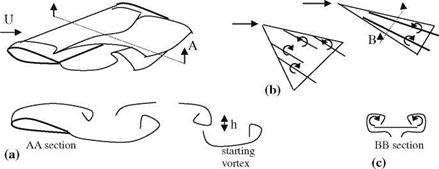Modern Subjects
Most of the material we have studied so far in general are the topics belonging to classical aerodynamics related to flows past thin or slender objects in small angles of attack for the purpose of generating lift. After the 1970s we see that the boundaries of classical aerodynamics are crossed because of advances made in computational as well as experimental techniques. The flow field analysis of low aspect ratio wings with high swept leading edges at high angles of attack enabled researchers to predict the extra lift generated because of leading edge separation which is exactly the case for some of the biological flows in nature. Utilization of leading edge separation helped aerodynamicists to design highly maneuverable military aircrafts to be used for military purposes. As is known from the classical aerodynamics, the leading edge separation from the wings with a little sweep or no-sweep, on the other hand, causes lift loss. This type of wing must have high lift while cruising at a constant speed and during landing with low speeds must have even higher lift without stalling. Otherwise, unsymmetrical lift loss, either from the left or right wing creates a rolling moment about the axis of the plane, and this causes it to rock. The larger roll moments about the axis of the plane cause spin (Katz and Plotkin 1991).
Since it is not possible to solve the separated flow fields with analytical methods, we have to resort to experimental measurements and visualization techniques or to numerical methods. The numerical and the experimental methods are used together in complementary fashion for the analysis of separated flows to predict the aerodynamic characteristics of relevant configurations. In this chapter, first we are going to study in a detail the flow separation around an airfoil at a constant angle of attack. The sudden lift loss at a constant high angle of attack because of leading edge separation is called static stall. The numerical as well as experimental studies about static stall will be given. Afterwards, the flow separation and the related lift loss at variable angle of attack which is called ‘dynamic stall’ are going to be analyzed in detail. Finally, three dimensional analyses of swept wings with extra lift created by leading edge separation will be studied. The summary of leading edge flow separation and the vortex sheet formations are shown in Fig. 8.1 for both swept and unswept wings. According to Fig. 8.1a (adapted from Katz and Plotkin 1991), for an unswept wing with high
U. Gulfat, Fundamentals of Modern Unsteady Aerodynamics, 245
DOI: 10.1007/978-3-642-14761-6_8, © Springer-Verlag Berlin Heidelberg 2010
|
A B
Fig. 8.1 Leading edge separation from a wing with a no sweep, b moderate sweep-weak vorticies, c high sweep-strong vortices |
aspect ratio there is a two dimensional separation as indicated with A-A cross section. In this two dimensional separation, the clockwise vortices leaving the leading edge and the counter clockwise vortices leaving the bottom surface at the trailing edge form a periodically formed vortex street at the wake of the wing. If h is the vertical distance between the centers of clockwise and counter clockwise vortices, f is the frequency of vortex generation, and U is the free stream speed then the Strouhal number for average Reynolds numbers reads as (Katz and Plotkin 1991)
fh
St = U ^ 0.1 – 0.2. (8.1)
The wings with moderate sweep at their leading edges have the flow separation with more than one vortex at each side of the wing as shown in Fig. 8.1b. Shown in Fig. 8.1c is the wing with the high sweep, K > 70°, which generates a pair of very strong vortices to roll up immediately after separating from the sharp leading edge, section BB. These high strength vortices generate suction at the upper surface which in turn creates additional lift. The pair of counter rotating vortices generated by the leading edge separation at higher angles of attack of the highly swept wings tends to have their symmetric strength uneven. This causes a rolling moment about the axis of the wing. Initially the rolling moment is small and periodic in nature; therefore, it causes the wing to rock. Further increase in angle of attack causes sudden burst of one of the vortices. This puts the wing in spin. Both wing rock and spin are the unsteady motions induced by the flow.
The periodic heaving and/or pitching motion of an airfoil, as a forced oscillation, is for long known to be the major source of thrust generation for flapping wings. During this type of oscillations the flow separation takes place at a larger angle of attack than the angle at which the static stall occurs. The value of reduced frequency of oscillation plays an important role in determining the lower limit of the angle of attack at which the dynamic stall takes place. Now, starting from static stall let us see the unsteady aerodynamic aspect of the phenomena which can be included in modern subjects.












